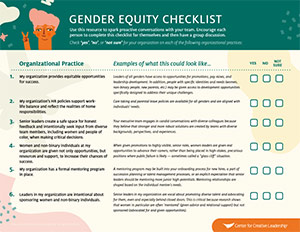Is your organization doing everything that it can to achieve gender equity in the workplace?
Studies have consistently shown that boosting diversity and gender equity in the workplace benefits organizations and their bottom lines, and our researchers have confirmed that having more women in the workplace increases wellbeing for all employees.
But getting there isn’t easy. Everyone — from senior organizational leaders and HR teams, to male colleagues at all levels, to individual women themselves — has a role to play.
Broadly, organizations and individuals striving for gender equity in the workplace need to rethink systems and challenge assumptions in order to cultivate an organizational culture capable of harnessing the power of all genders.
Starting a Conversation About Gender Equity in the Workplace
Download our free resource to help spark productive conversations and begin taking steps toward greater gender equity in the workplace and on your team today.
Increasing Gender Equity in the Workplace Involves Everyone
Equity is a systemic issue, and as such, making lasting change towards greater gender equity in the workplace requires getting the whole organization involved. Senior organizational leaders can implement key practices to help overcome barriers to women’s leadership and begin to help leaders of all genders feel able to bring their full selves to work.
Getting Started: 7 Key Action Steps for HR Teams & Organizational Leaders
Here are 7 first steps to take towards building gender equity in the workplace:
1. Gain commitment from board members and senior executives.
Addressing the barriers and experiences of women — generally and in your specific organizational context – requires involvement and support from the top. Senior leaders have a crucial role to play in EDI (equity, diversity, and inclusion) initiatives because reinvention must come from the top and executives must lead by example.
2. Rethink systems.
Don’t place the burden of driving gender equity in the workplace on individuals. Senior leaders must consider and understand what organizational policies and practices may be seen as supportive or dismissive of talented women and shift toward more inclusive leadership. Best-practice organizations have an all-encompassing, systematic agenda to tackle gender equity in the workplace and are focused on supporting, retaining, and promoting diversity of all kinds.
3. Establish and execute flexible work arrangements.
Flexible work arrangements can take many forms, and even before the pandemic, flexibility was frequently cited as one of the key things wanted by women in the workplace. With the global shift toward more hybrid and remote ways of working, your organization will surely improve employee retention post-pandemic with flexible work arrangements. But even more important than establishing flexible policies is ensuring that employees feel truly “safe” to take advantage of them.
4. Provide learning and development opportunities.
Women want and need development opportunities — including stretch assignments. Organizations that are serious about attracting, supporting, retaining and promoting women leaders need to provide opportunities for them to grow throughout their career journeys and at all levels of the talent pipeline.
5. Help managers develop talent through coaching and mentoring.
Leaders need to understand the important role they play in supporting development to further the goal of gender equity in the workplace. Equip managers with skills and tools for successful mentoring at work. Offer developmental training on how to make the most out of the diverse talent pool. Provide guidance through tools, and provide coaching and mentoring support to new leaders especially so they’re prepared when they come across unexpected situations.
6. Endorse employee resource groups.
Our research has found that many women have benefited from women’s groups that allowed a safe space to discuss challenges, seek solutions, and access networking opportunities that they might not have otherwise encountered. Organizations can endorse and support formal employee resource groups as a way to shape culture, engage employees, communicate information, and provide resources. Of course, resource groups can be formed based on other common interests, backgrounds, and identities, too, and should acknowledge intersectional identities, such as women of color or mothers. For example, a resource group for new parents or Black professionals may also help to support and retain more talent at your organization.
7. Think beyond gender diversity.
Gender equity in the workplace is a wonderful aim, but the ultimate goal for your organization is to create a culture where all voices are heard and all talent feels respected. That’s why at CCL, we advocate for kick-starting diversity efforts with a focus first on equity. Incorporate building equity, diversity, and inclusion (EDI) into your organizational value proposition, clarify a global and a local strategy to support EDI, and consider appointing an executive-level position for EDI such as Chief Diversity Officer. Your organization may also want to partner with an external provider for multi-phased learning across the organization on topics such as moving beyond unconscious bias, leading inclusively, building understanding of social identity and effective allyship, and establishing organizational programs that go beyond mentoring women to sponsoring them.
Men Play a Critical Role in Increasing Gender Equity in the Workplace
Gender equity often gets pegged as “a women’s issue” and because of this, is often left to women to address. Some men might even feel uncomfortable participating in discussions around gender because they might assume it’s not their place. But in reality, we’re unlikely to ever reach true gender equity in the workplace unless everyone gets involved — particularly men.
Here are 5 specific things that men can do:
1. Participate in discussions of women and leadership.
Men’s participation in discussions of gender equity in the workplace introduces different dynamics to the conversation and can signal to others that it’s more than just “a women’s issue.” As long as psychological safety is present, holding candid, open discussions creates space for listening to others share about their experiences, widening perspectives, building shared understanding and awareness, and unlocking the power of respect.
2. Take conscious actions.
Effective allyship requires taking daily, intentional actions that contribute to a more inclusive and equitable environment. For example, being careful to avoid using gendered language in meetings by saying “you all” instead of “you guys” and banning use of the word “bossy” in reference to women or girls are very small ways to make a difference. Consciously support women in such small ways and in bigger ones too, such as at critical decision points in the hiring, selection, and promotion process, or when providing developmental opportunities.
3. Challenge assumptions.
When decision-makers question whether a woman would really want a new role, perhaps because it would require long hours or relocating, men can support greater gender equity in the workplace by challenging the unspoken, underlying assumption that a woman would likely not want the opportunity. Suggest to others the organization give her space to answer for herself by saying, “Let’s ask her.” Challenging assumptions also means considering the possibility for different styles and skillsets: “Here’s the profile of the last person in this job … but what competencies might we need now?”
4. Provide challenging opportunities and task-focused feedback.
Research has found that women are not given the kind of feedback they need to improve or take the next step as often as their male colleagues are, and other studies have shown that women are given fewer stretch assignments. Men can commit to giving their female direct reports and colleagues helpful, constructive, actionable feedback rather than vague or personal feedback, and steering women toward needed assignments and challenging opportunities to help them grow as leaders.
5. Lend your network.
The right relationships and ties are assets in getting access to information, earning promotions, and gaining opportunities. Effective leaders rely on networks to influence others and to get results. Men can use their access to networks to create connections and open doors for talented women colleagues. Learn more about why women need a network of champions, including mentors and sponsors, and how you can be one.
Women, Consider These Tips to Shift Your Mindset
While gender equity in the workplace is certainly impossible without organizational changes, these 6 mindset shifts can help individual women tackle some of the gender equity challenges they may experience at work.
1. Face challenges with confidence.
Leadership roles come with uncertainty. Don’t fall into the trap of questioning your capabilities or waiting until you think you’re 100% ready for a challenge. If you do, you’ll miss opportunities. Work to overcome impostor syndrome.
2. Be intentional about development.
Be deliberate about your development as a leader. Take the lead in shaping conversations about your career and take ownership of your career choices. Consciously build and strengthen your personal leadership brand.
3. Find allies and advocates.
Both mentoring and sponsorship are important for career advancement, but women often find themselves over-mentored and under-sponsored. Find someone to advocate for you, and build your network intentionally. (If that feels a little uncomfortable or challenging, check out our networking tips for women.)
4. Speak up, and give credit where credit is due.
Leadership is about influence. Women have knowledge, skills, and perspectives that will benefit their teams and organizations. But if you don’t speak up, you lose the opportunity to influence. Women are more likely to credit “luck” for their successes, perhaps because women who promote themselves are sometimes seen as less likable. But a little authentic self-promotion can prevent you — and those around you — from overlooking or discounting hard work.
5. Define success for yourself.
The answer to the question: “Do I have the ‘hunger’?” is a key differentiator between women who achieve senior leadership roles and those who don’t, according to another one of our research studies. Women who strive to reach the C-suite need to dig deep and find the drive and tenacity needed for that long and challenging leadership journey. On the other hand, research also shows that women tend to have more varied interests in career and life paths compared to men. If you’re not interested in the C-suite, that doesn’t mean you’re unsuccessful at all. What matters is for you to understand the keys to success for women and your own values, and then to be ambitious about pursuing that success, whatever it means to you. It’s all part of living with intention.
A Final Word on Increasing Gender Equity in the Workplace
Now that you understand the many different ways that organizations and individuals can work together to promote greater gender equity in the workplace, talk with your colleagues about it.
Ready to Take the Next Step?
After you download our Gender Equity Conversation-Starter Checklist, keep on learning and growing: never miss our exclusive leadership insights and tips — subscribe to our newsletters to get our research-based articles, webinars, and guides delivered straight to your inbox.
Download our free resource to help spark productive conversations and begin taking steps toward greater gender equity in the workplace and on your team today.








